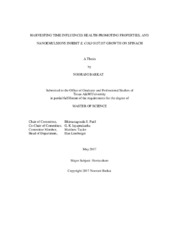| dc.description.abstract | Spinach (Spinacia oleracea) is a leafy vegetable, rich in health-promoting compounds such as flavonoids, carotenoids, chlorophylls, ascorbic acid, vitamins, and dietary fiber. In the first study, we measured levels of various phytochemicals in spinach at different growing times. Spinach was harvested at 20, 30, 40, 50, and 60 days after planting. Our results demonstrated that nitrate levels increased from 20 (1909 µg g-1) to day 40 (3668 µg g-1) then decreased (974 µg g-1) at day 60. Lutein, chlorophyll a and b were higher in 60 day samples and β-carotene contents were higher at 50 days. Twelve flavonoids were identified. Total phenolics ranged from 885 to 1162 µg/g. Spinach at 30, 40, and 60 days inhibited α-amylase activity at rates similar to acarbose (inhibitor). Bile acid binding potential was maximal in all samples. This study showed that harvest time has major effect on phytochemical levels and mature spinach has highest phytochemical levels.
The second study aimed to prepare stable nanoemulsions (NE) using grapefruit and lemon essential oils (EO) to evaluate their antimicrobial properties against Escherichia coli O157:H7. Encapsulation of these EO’s in NE aided inhibition of pathogen growth on spinach during refrigerated (5°C) storage. Particle sizes of grapefruit and lemon NE were 303 and 155 nm, respectively. Spinach samples were inoculated with E. coli O157:H7, and then treated with one of three different treatments (control, 200 ppm chlorine, 5% grapefruit oil NE or 3% lemon oil NE [v/v]). The efficacy of the antimicrobial treatments was determined according to E. coli O157:H7 survival at 0, 3, 6, and 9 days of storage. Chlorine and 3% lemon NE exhibited greater iii inhibitory effects against E. coli O157:H7 versus the grapefruit NE. Nonetheless, all treatments produced significant reductions in pathogen numbers on spinach compared to untreated controls. Significant reduction was observed on each storage day with chlorine treatment and 3% lemon NE with 2.4 and 1.6 log10-cycles reduction on day 0, respectively, and the highest reductions were observed on 9th day of storage with 4.3 and 5.4 log10-cycles reduction. These findings indicated the potential of these natural EO for decontamination of fresh produce. | en |


